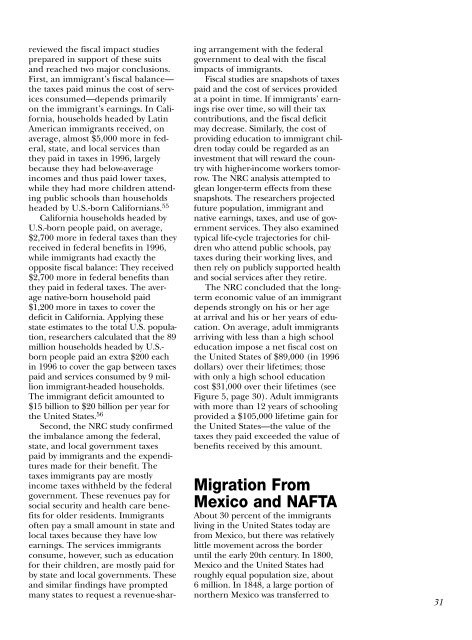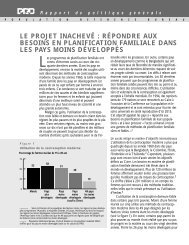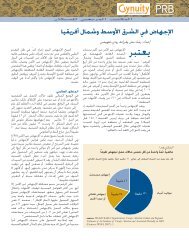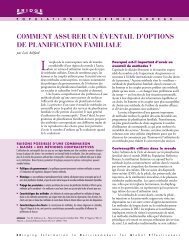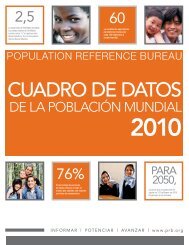Immigration Shaping America - Population Reference Bureau
Immigration Shaping America - Population Reference Bureau
Immigration Shaping America - Population Reference Bureau
Create successful ePaper yourself
Turn your PDF publications into a flip-book with our unique Google optimized e-Paper software.
eviewed the fiscal impact studies<br />
prepared in support of these suits<br />
and reached two major conclusions.<br />
First, an immigrant’s fiscal balance—<br />
the taxes paid minus the cost of services<br />
consumed—depends primarily<br />
on the immigrant’s earnings. In California,<br />
households headed by Latin<br />
<strong>America</strong>n immigrants received, on<br />
average, almost $5,000 more in federal,<br />
state, and local services than<br />
they paid in taxes in 1996, largely<br />
because they had below-average<br />
incomes and thus paid lower taxes,<br />
while they had more children attending<br />
public schools than households<br />
headed by U.S.-born Californians. 55<br />
California households headed by<br />
U.S.-born people paid, on average,<br />
$2,700 more in federal taxes than they<br />
received in federal benefits in 1996,<br />
while immigrants had exactly the<br />
opposite fiscal balance: They received<br />
$2,700 more in federal benefits than<br />
they paid in federal taxes. The average<br />
native-born household paid<br />
$1,200 more in taxes to cover the<br />
deficit in California. Applying these<br />
state estimates to the total U.S. population,<br />
researchers calculated that the 89<br />
million households headed by U.S.-<br />
born people paid an extra $200 each<br />
in 1996 to cover the gap between taxes<br />
paid and services consumed by 9 million<br />
immigrant-headed households.<br />
The immigrant deficit amounted to<br />
$15 billion to $20 billion per year for<br />
the United States. 56<br />
Second, the NRC study confirmed<br />
the imbalance among the federal,<br />
state, and local government taxes<br />
paid by immigrants and the expenditures<br />
made for their benefit. The<br />
taxes immigrants pay are mostly<br />
income taxes withheld by the federal<br />
government. These revenues pay for<br />
social security and health care benefits<br />
for older residents. Immigrants<br />
often pay a small amount in state and<br />
local taxes because they have low<br />
earnings. The services immigrants<br />
consume, however, such as education<br />
for their children, are mostly paid for<br />
by state and local governments. These<br />
and similar findings have prompted<br />
many states to request a revenue-sharing<br />
arrangement with the federal<br />
government to deal with the fiscal<br />
impacts of immigrants.<br />
Fiscal studies are snapshots of taxes<br />
paid and the cost of services provided<br />
at a point in time. If immigrants’ earnings<br />
rise over time, so will their tax<br />
contributions, and the fiscal deficit<br />
may decrease. Similarly, the cost of<br />
providing education to immigrant children<br />
today could be regarded as an<br />
investment that will reward the country<br />
with higher-income workers tomorrow.<br />
The NRC analysis attempted to<br />
glean longer-term effects from these<br />
snapshots. The researchers projected<br />
future population, immigrant and<br />
native earnings, taxes, and use of government<br />
services. They also examined<br />
typical life-cycle trajectories for children<br />
who attend public schools, pay<br />
taxes during their working lives, and<br />
then rely on publicly supported health<br />
and social services after they retire.<br />
The NRC concluded that the longterm<br />
economic value of an immigrant<br />
depends strongly on his or her age<br />
at arrival and his or her years of education.<br />
On average, adult immigrants<br />
arriving with less than a high school<br />
education impose a net fiscal cost on<br />
the United States of $89,000 (in 1996<br />
dollars) over their lifetimes; those<br />
with only a high school education<br />
cost $31,000 over their lifetimes (see<br />
Figure 5, page 30). Adult immigrants<br />
with more than 12 years of schooling<br />
provided a $105,000 lifetime gain for<br />
the United States—the value of the<br />
taxes they paid exceeded the value of<br />
benefits received by this amount.<br />
Migration From<br />
Mexico and NAFTA<br />
About 30 percent of the immigrants<br />
living in the United States today are<br />
from Mexico, but there was relatively<br />
little movement across the border<br />
until the early 20th century. In 1800,<br />
Mexico and the United States had<br />
roughly equal population size, about<br />
6 million. In 1848, a large portion of<br />
northern Mexico was transferred to<br />
31


